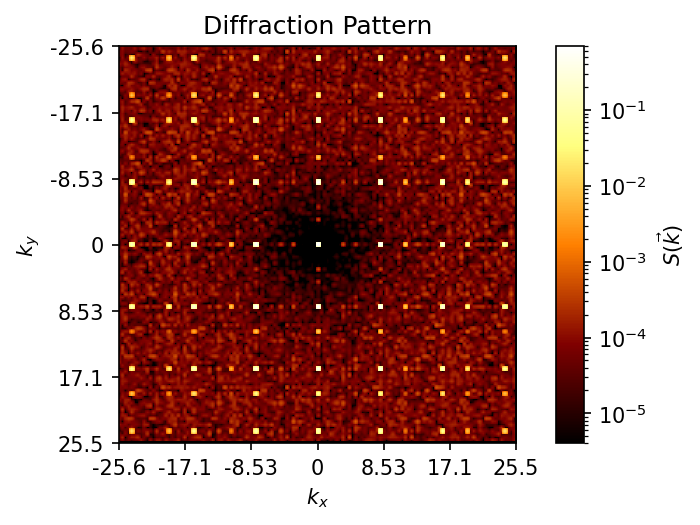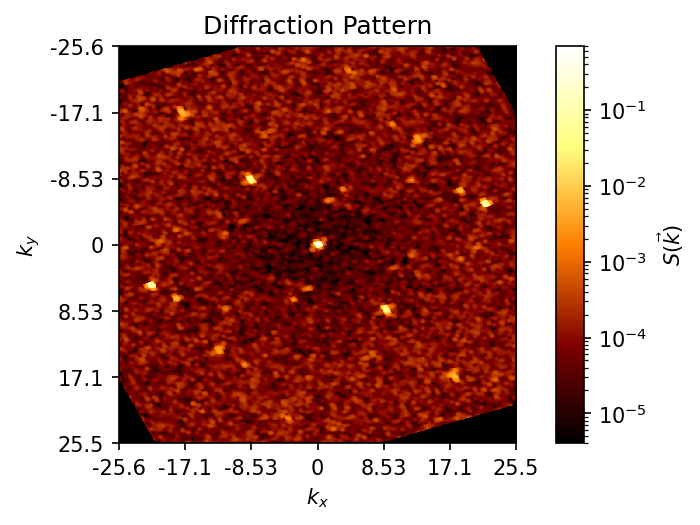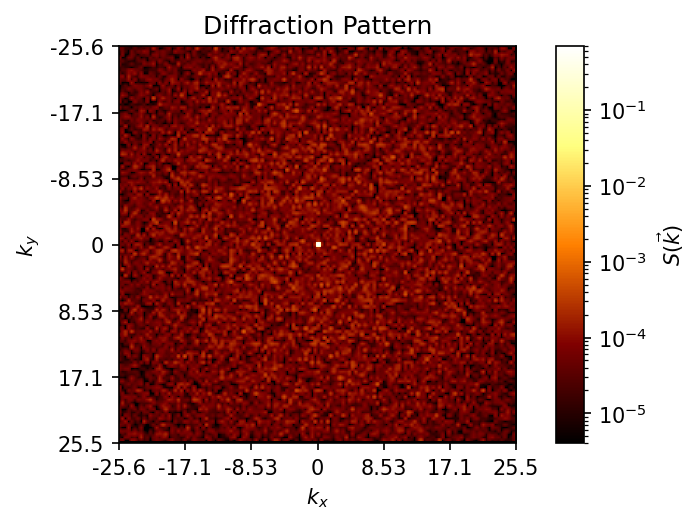freud.diffraction.DiffractionPattern¶
The freud.diffraction.DiffractionPattern class computes a diffraction pattern, which is a 2D image of the static structure factor \(S(\vec{k})\) of a set of points.
[1]:
import freud
import matplotlib.pyplot as plt
import numpy as np
import rowan
First, we generate a sample system, a face-centered cubic crystal with some noise.
[2]:
box, points = freud.data.UnitCell.fcc().generate_system(num_replicas=10, sigma_noise=0.02)
Now we create a DiffractionPattern compute object.
[3]:
dp = freud.diffraction.DiffractionPattern(grid_size=512, output_size=512)
Next, we use the compute method and plot the result. We use a view orientation with the identity quaternion [1, 0, 0, 0] so the view is aligned down the z-axis.
[4]:
fig, ax = plt.subplots(figsize=(4, 4), dpi=150)
dp.compute((box, points), view_orientation=[1, 0, 0, 0])
dp.plot(ax)
plt.show()

We can also use a random quaternion for the view orientation to see what the diffraction looks like from another axis.
[5]:
fig, ax = plt.subplots(figsize=(4, 4), dpi=150)
np.random.seed(0)
view_orientation = rowan.random.rand()
dp.compute((box, points), view_orientation=view_orientation)
print('Looking down the axis:', rowan.rotate(view_orientation, [0, 0, 1]))
dp.plot(ax)
plt.show()
Looking down the axis: [0.75707404 0.33639217 0.56007071]

The DiffractionPattern object also provides \(\vec{k}\) vectors in the original 3D space and the magnitudes of \(k_x\) and \(k_y\) in the 2D projection along the view axis.
[6]:
print('Magnitudes of k_x and k_y along the plot axes:')
print(dp.k_values[:5], '...', dp.k_values[-5:])
Magnitudes of k_x and k_y along the plot axes:
[-25.6 -25.5 -25.4 -25.3 -25.2] ... [25.1 25.2 25.3 25.4 25.5]
[7]:
print('3D k-vectors corresponding to each pixel of the diffraction image:')
print('Array shape:', dp.k_vectors.shape)
print('Center value: k =', dp.k_vectors[dp.output_size//2, dp.output_size//2, :])
print('Top-left value: k =', dp.k_vectors[0, 0, :])
3D k-vectors corresponding to each pixel of the diffraction image:
Array shape: (512, 512, 3)
Center value: k = [0. 0. 0.]
Top-left value: k = [ 19.03669015 -29.77826902 -7.84723661]
We can also measure the diffraction of a random system (note: this is an ideal gas, not a liquid-like system, because the particles have no volume exclusion or repulsion). Note that the peak at \(\vec{k} = 0\) persists. The diffraction pattern returned by this class is normalized by dividing by \(N^2\), so \(S(\vec{k}=0) = 1\) after normalization.
[8]:
box, points = freud.data.make_random_system(box_size=10, num_points=10000)
fig, ax = plt.subplots(figsize=(4, 4), dpi=150)
dp.compute((box, points))
dp.plot(ax)
plt.show()
